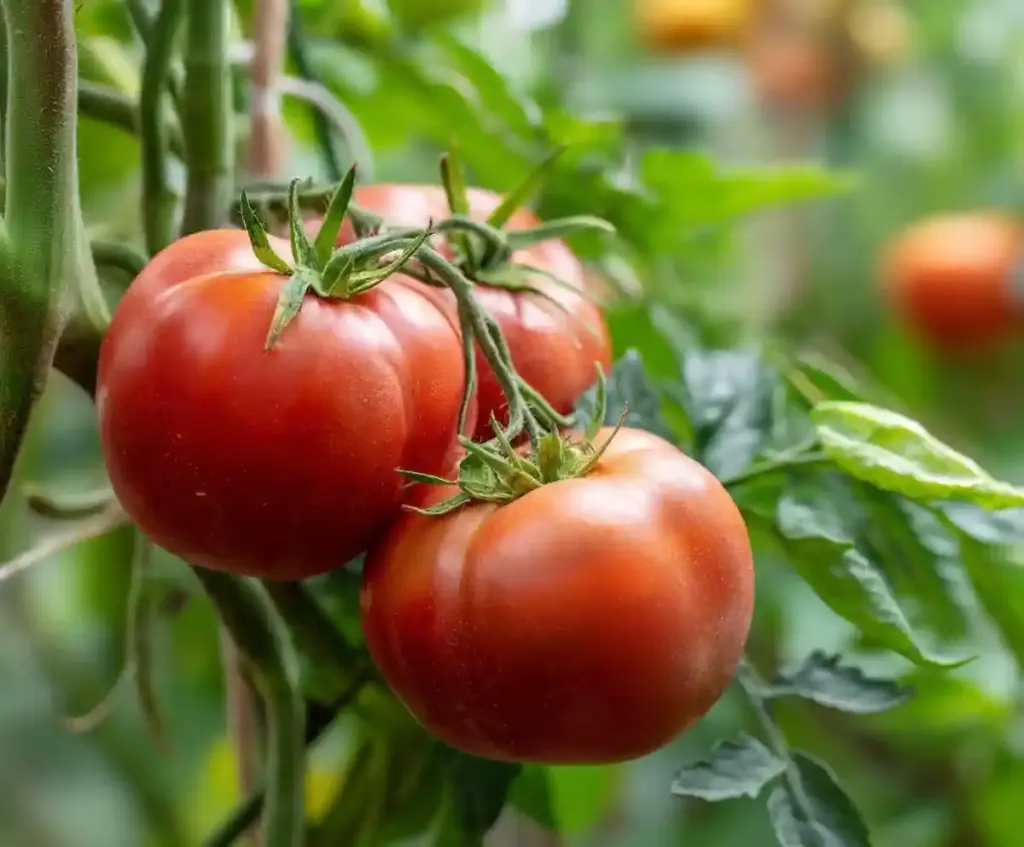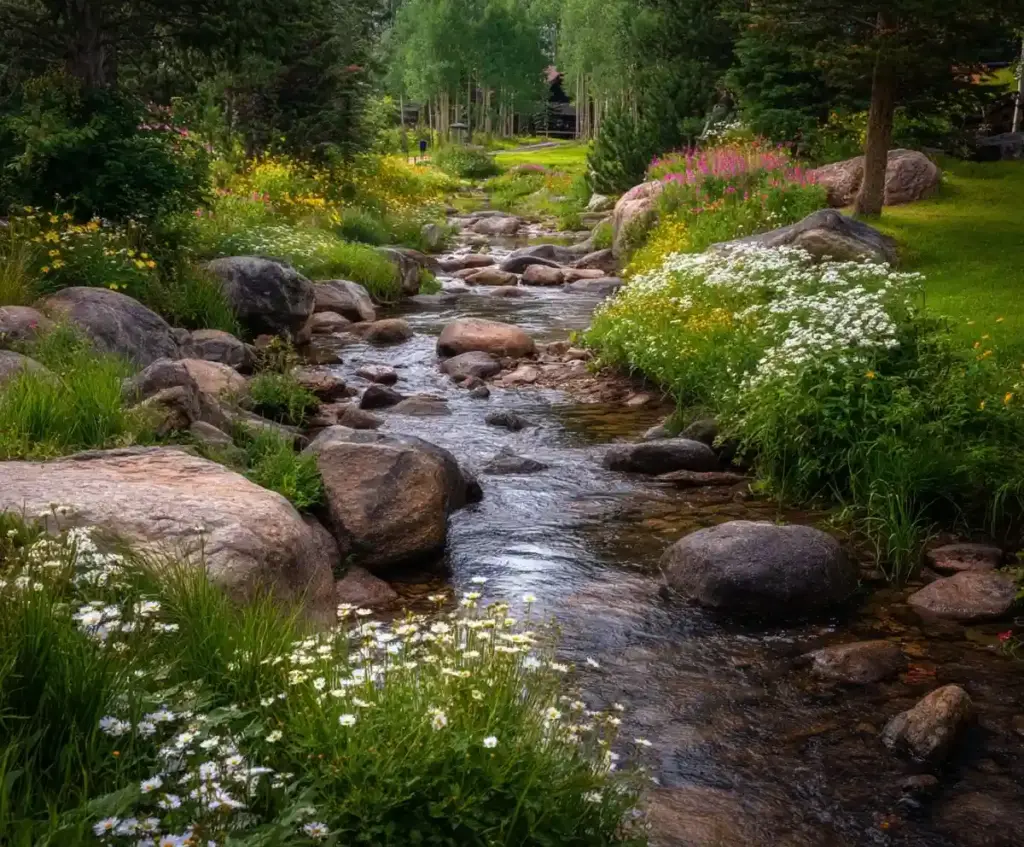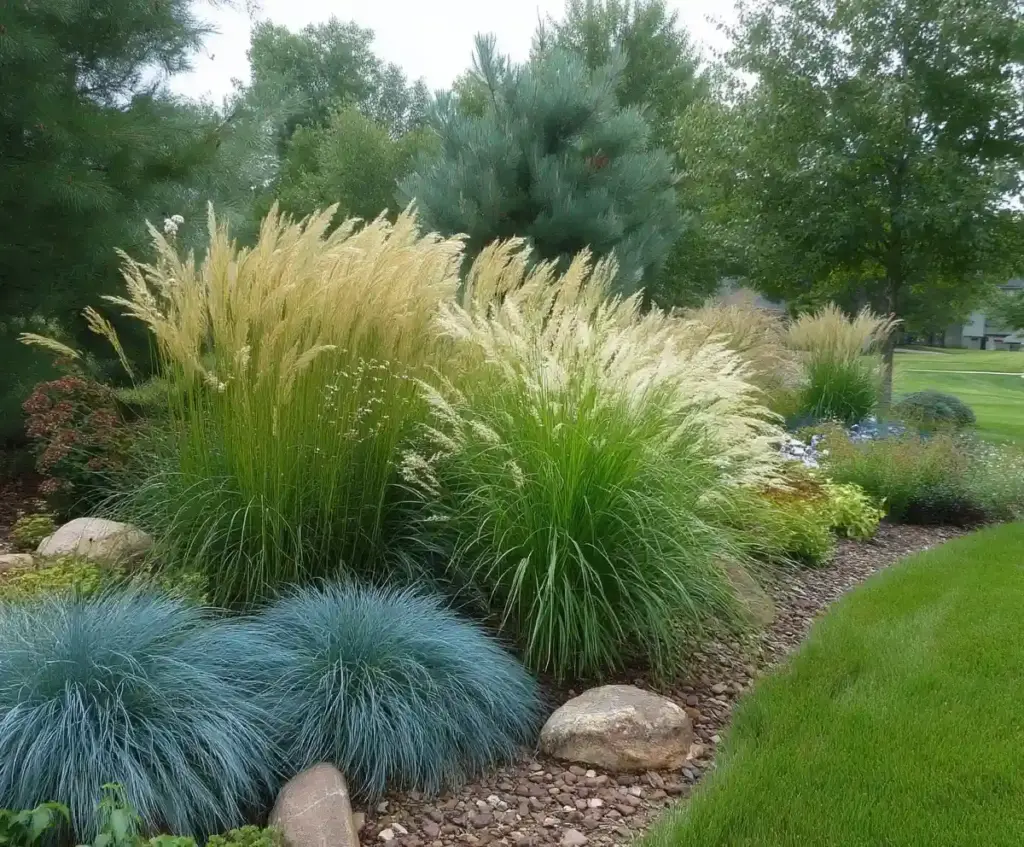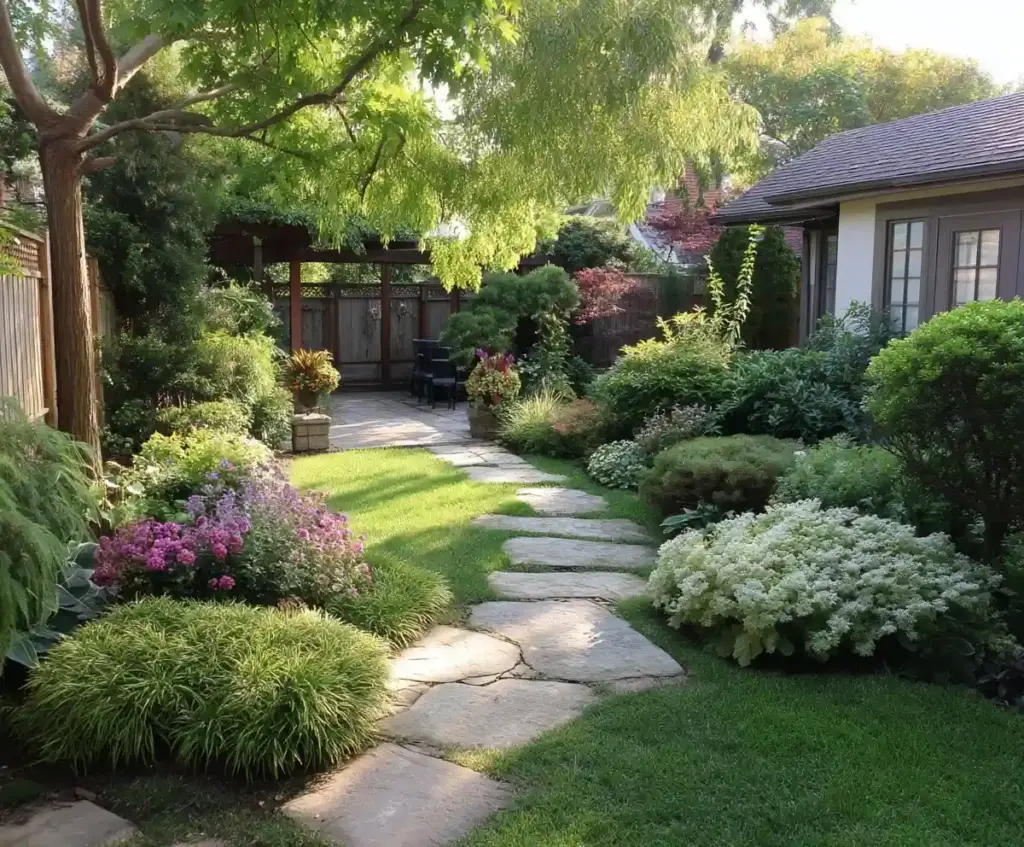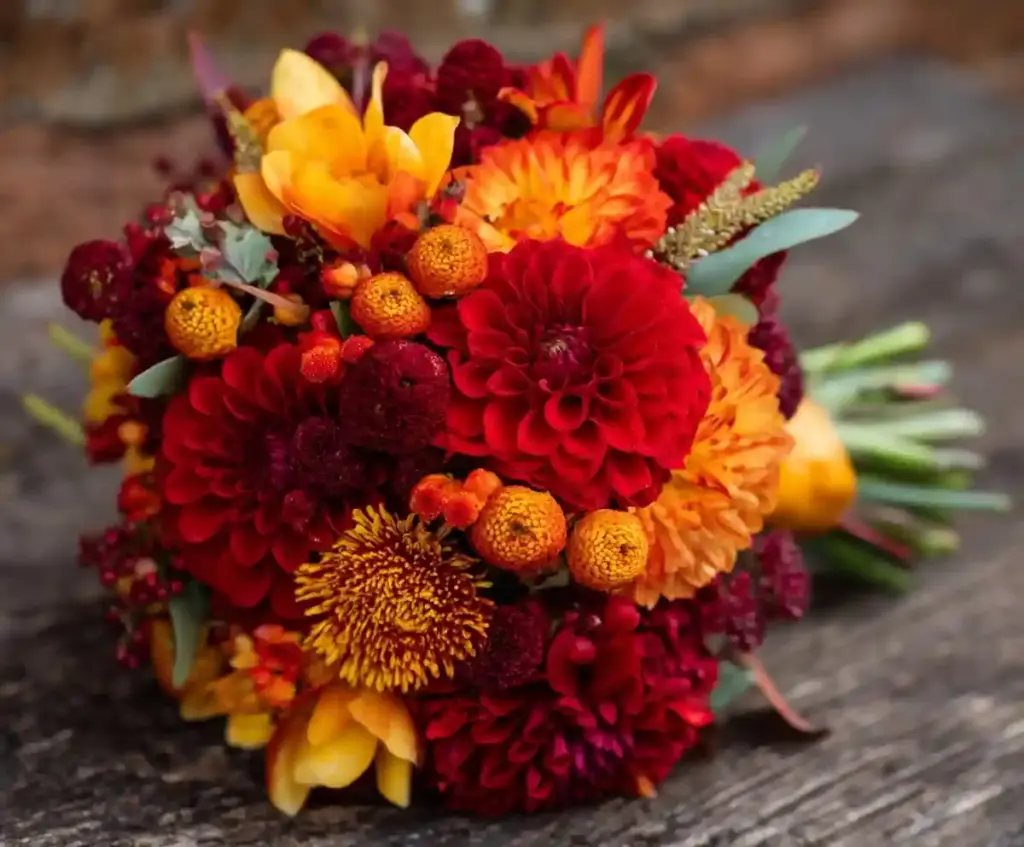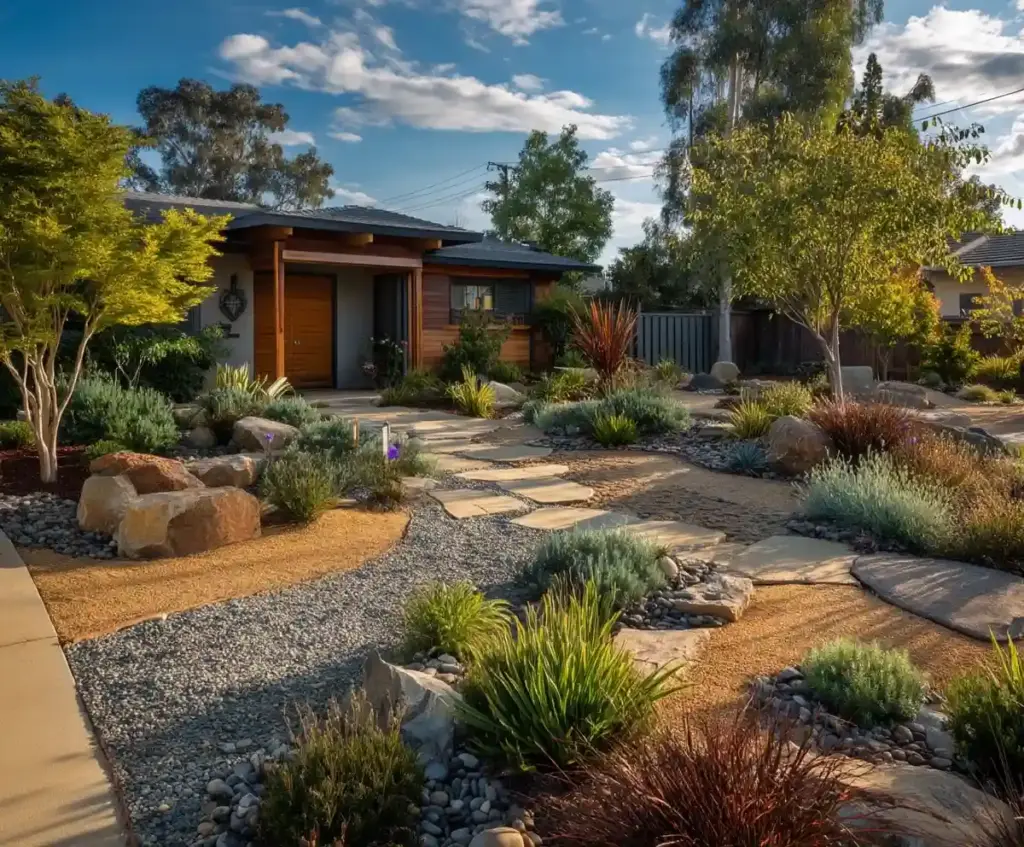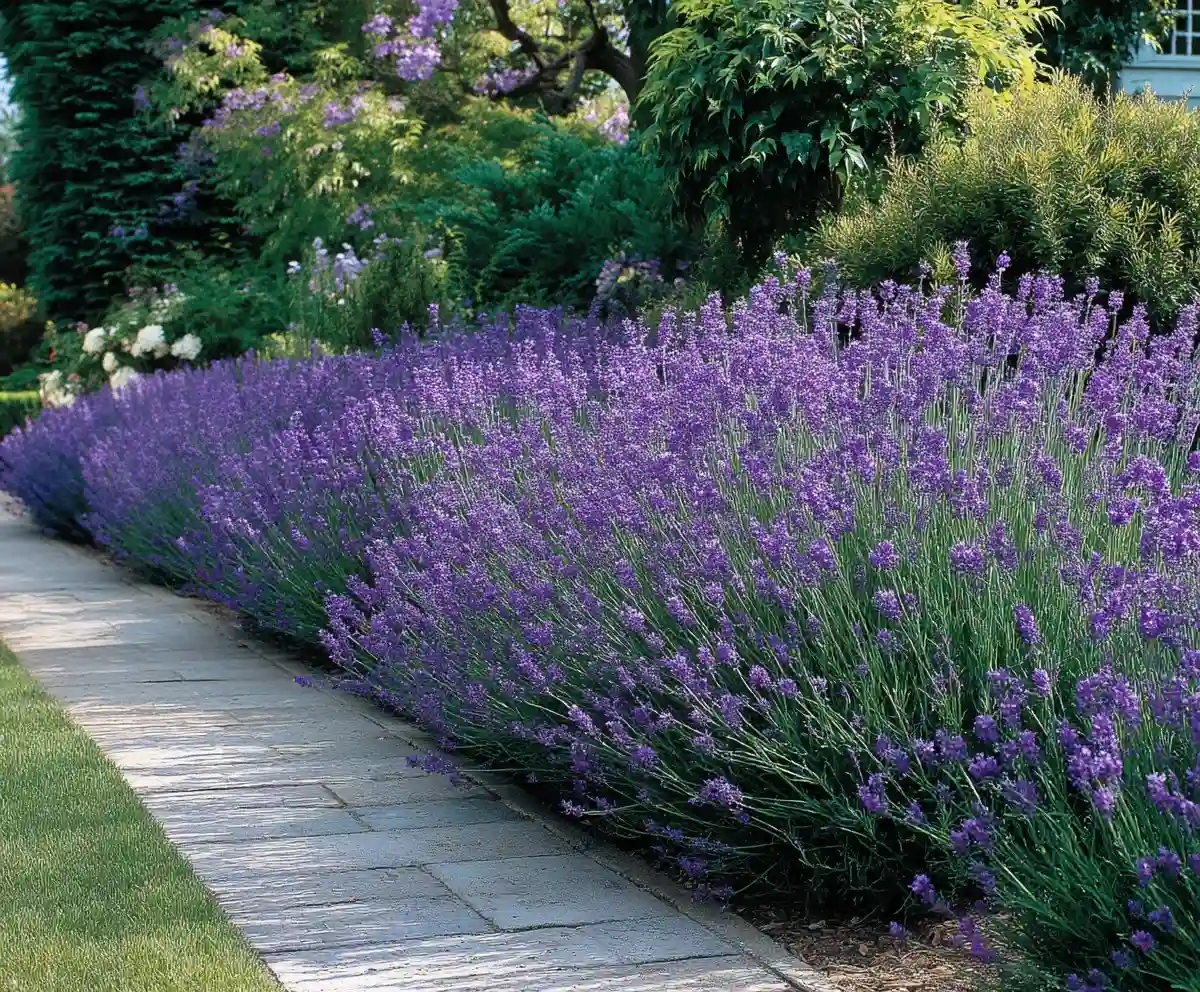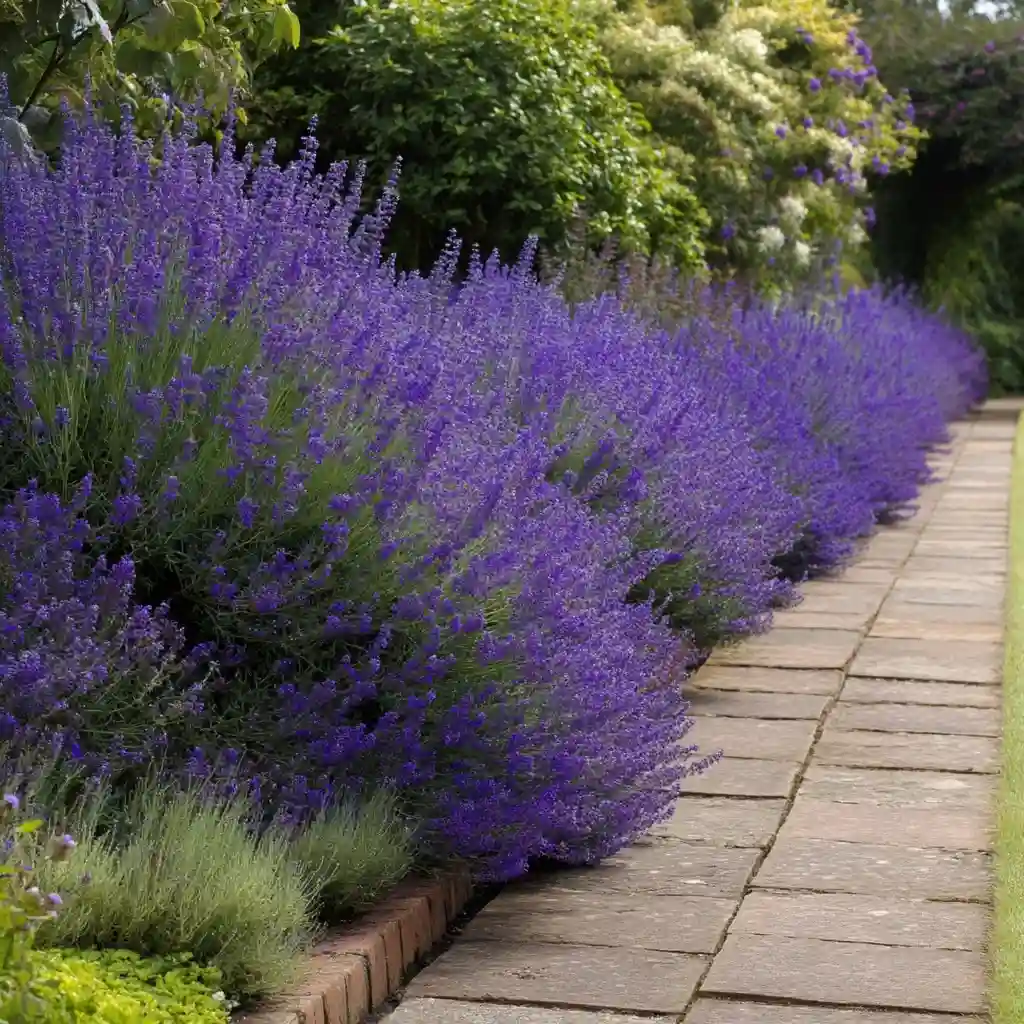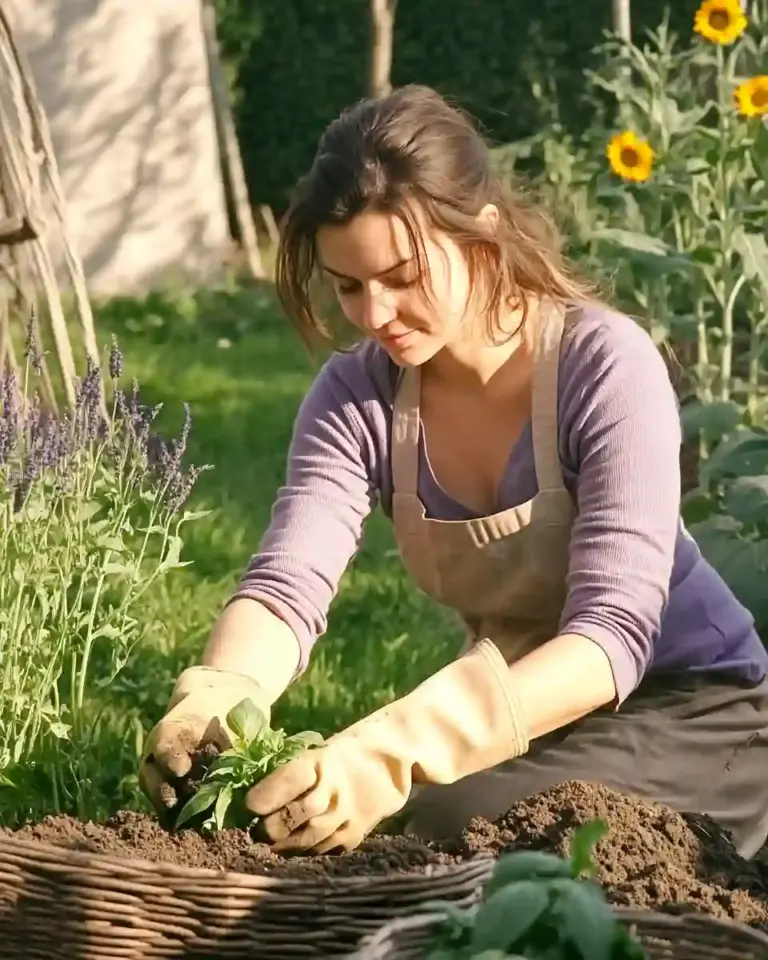Lavender garden ideas can completely transform your outdoor space into a peaceful, fragrant retreat. Whether you’re aiming for a charming cottage-style walkway or a Mediterranean-inspired courtyard, lavender’s soothing scent and vibrant color make it an ideal addition to any landscape. From compact patios to sprawling backyard borders, this versatile herb fits beautifully into all kinds of garden designs.
In this guide, you’ll discover creative ways to plant and style lavender that not only boost curb appeal but also support pollinators, resist deer, and require minimal maintenance. Each idea is designed to help you get the most beauty and relaxation from your garden—while making your yard smell absolutely heavenly.
Table of Contents
1. Lavender Hedge Border
Creating a lavender hedge border is one of the most timeless and practical lavender garden ideas for defining your landscape. Lavender’s dense, bushy growth and vibrant purple blooms make it an excellent natural fence that’s both beautiful and functional.
A lavender border can line walkways, driveways, or garden beds, offering structure while filling the air with its signature fragrance. Unlike traditional hedges that need constant trimming, lavender requires only light pruning once or twice a year, making it a low-maintenance favorite.
Tips for success:
- Choose English lavender for cooler climates or French lavender for warmer regions.
- Space plants 12 to 18 inches apart to encourage dense growth.
- Plant in full sun with well-draining soil to prevent root rot.
Not only does a lavender hedge create a stunning visual effect, but it also attracts bees and butterflies, boosting biodiversity in your yard.
2. Raised Lavender Garden Beds

Raised beds are a smart and stylish way to incorporate lavender garden ideas into small or challenging spaces. Elevating your lavender plants improves drainage, reduces soil compaction, and makes garden maintenance easier on your back.
This design is especially useful if your native soil retains too much moisture, which can lead to root rot in lavender. Raised beds allow you to customize the soil blend—ideal for mimicking the plant’s preferred Mediterranean conditions.
Design ideas:
- Use stone, brick, or untreated wood to build the beds for a natural look.
- Mix lavender with herbs like thyme and oregano for a functional and fragrant culinary bed.
- Arrange in geometric shapes for a modern aesthetic or irregular lines for a cottage-style feel.
Raised beds not only help lavender thrive but also add a clean, organized look to your garden layout, perfect for front yards or patios.
3. Lavender and Herb Spiral Garden
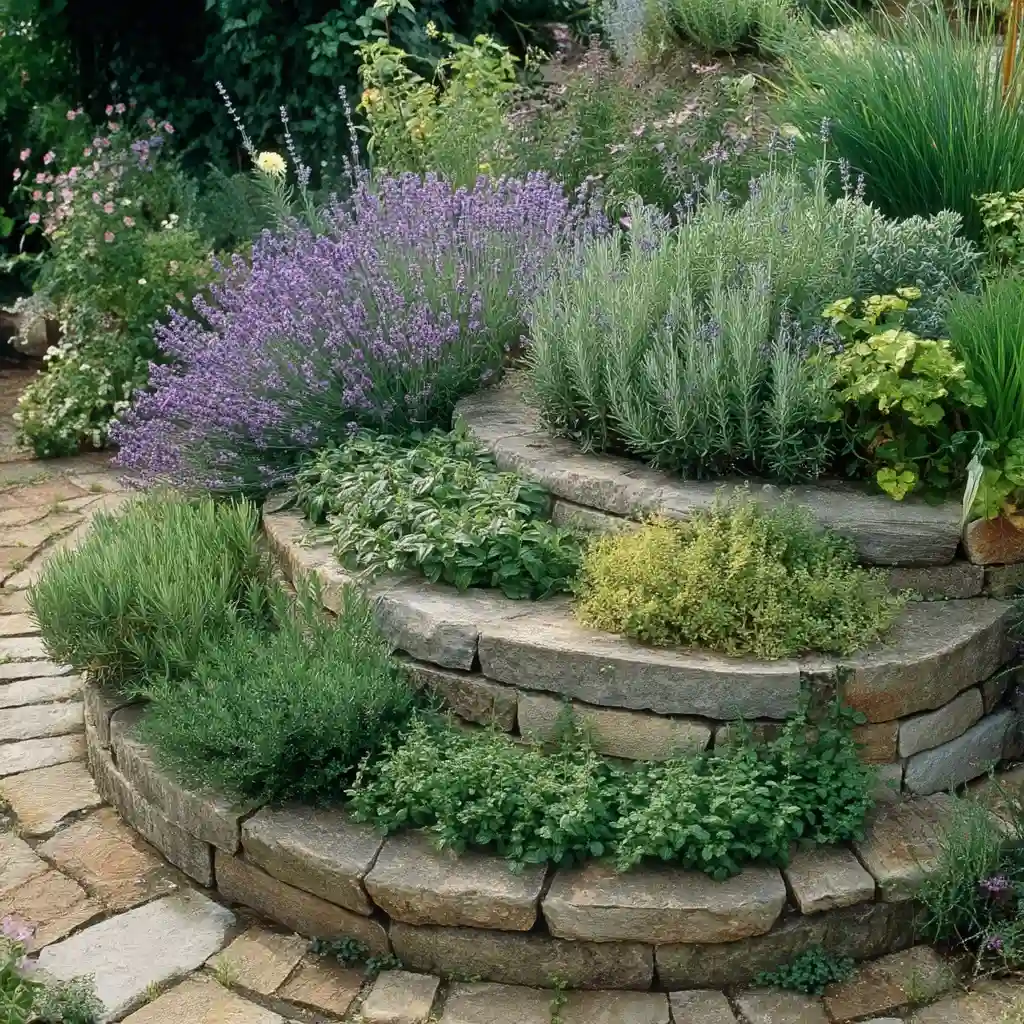
A herb spiral is one of the most visually striking and space-efficient lavender garden ideas—and adding lavender to the mix enhances both form and function. Built in a raised spiral shape, this design allows you to grow a variety of herbs with different sun and moisture needs in a compact footprint.
Lavender thrives at the top of the spiral where it gets the most sun and driest soil, while moisture-loving herbs like parsley and basil fit better near the base. This layered approach creates a microclimate effect, ideal for diverse planting.
Key features to include:
- Use rocks, bricks, or reclaimed materials to build the spiral.
- Fill with well-draining soil at the top and moisture-retaining soil toward the bottom.
- Add mulch around lavender for extra insulation and weed control.
This garden not only looks like a living sculpture, but it’s also practical—offering fresh herbs and fragrant lavender all within arm’s reach.
4. Cottage-Style Lavender Pathway
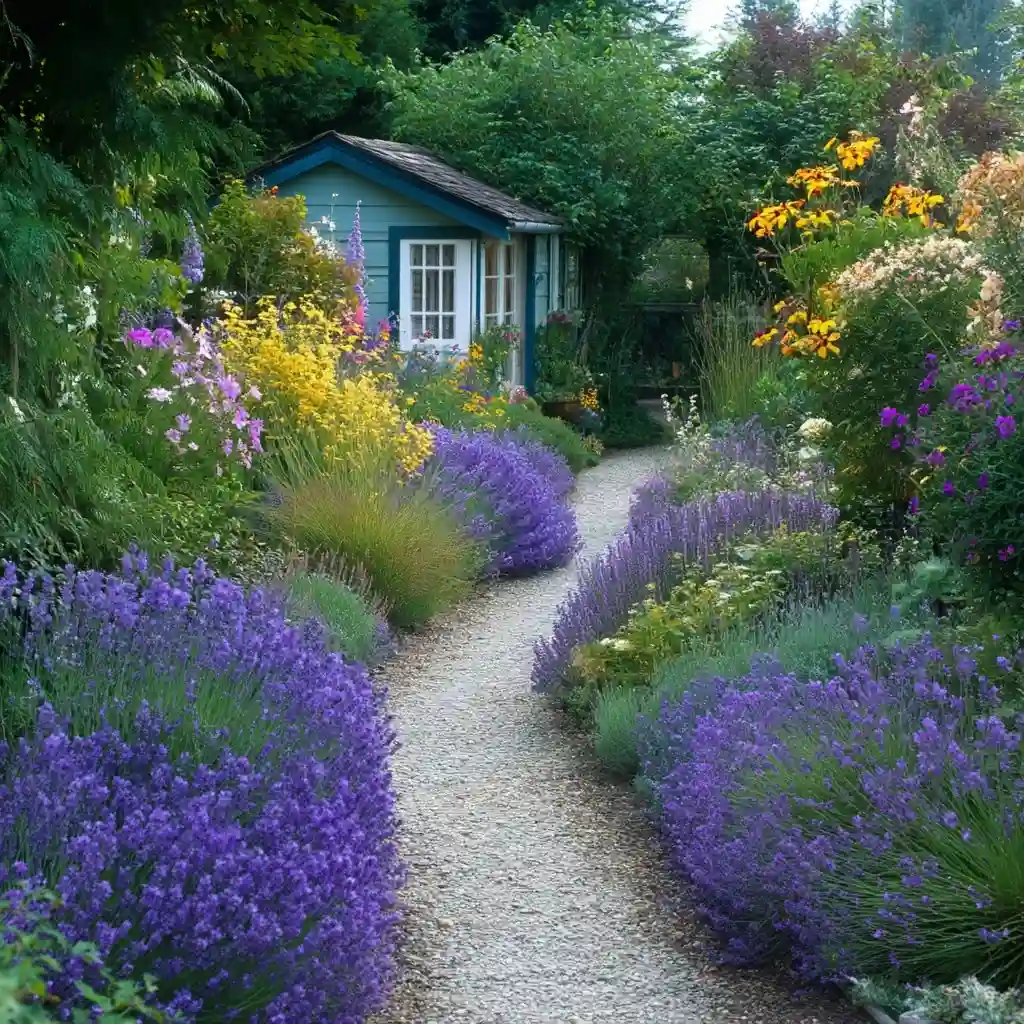
Few lavender garden ideas are as romantic and inviting as a cottage-style lavender pathway. Flanking a garden path with rows of blooming lavender instantly creates a storybook feel—blending fragrance, color, and old-world charm in one elegant design.
Whether your path is gravel, stepping stones, or bricks, lavender softens the edges and guides the eye through your landscape. Its upright growth and calming scent turn even the shortest walkway into a sensory experience.
Design tips:
- Use English lavender for its compact shape and classic look.
- Keep plants trimmed to maintain a tidy edge along the path.
- Add climbing roses or trailing vines nearby for added cottage appeal.
This pathway style is especially effective in front yards or leading to a garden gate, creating a welcoming atmosphere for guests and pollinators alike.
5. Lavender Rock Garden
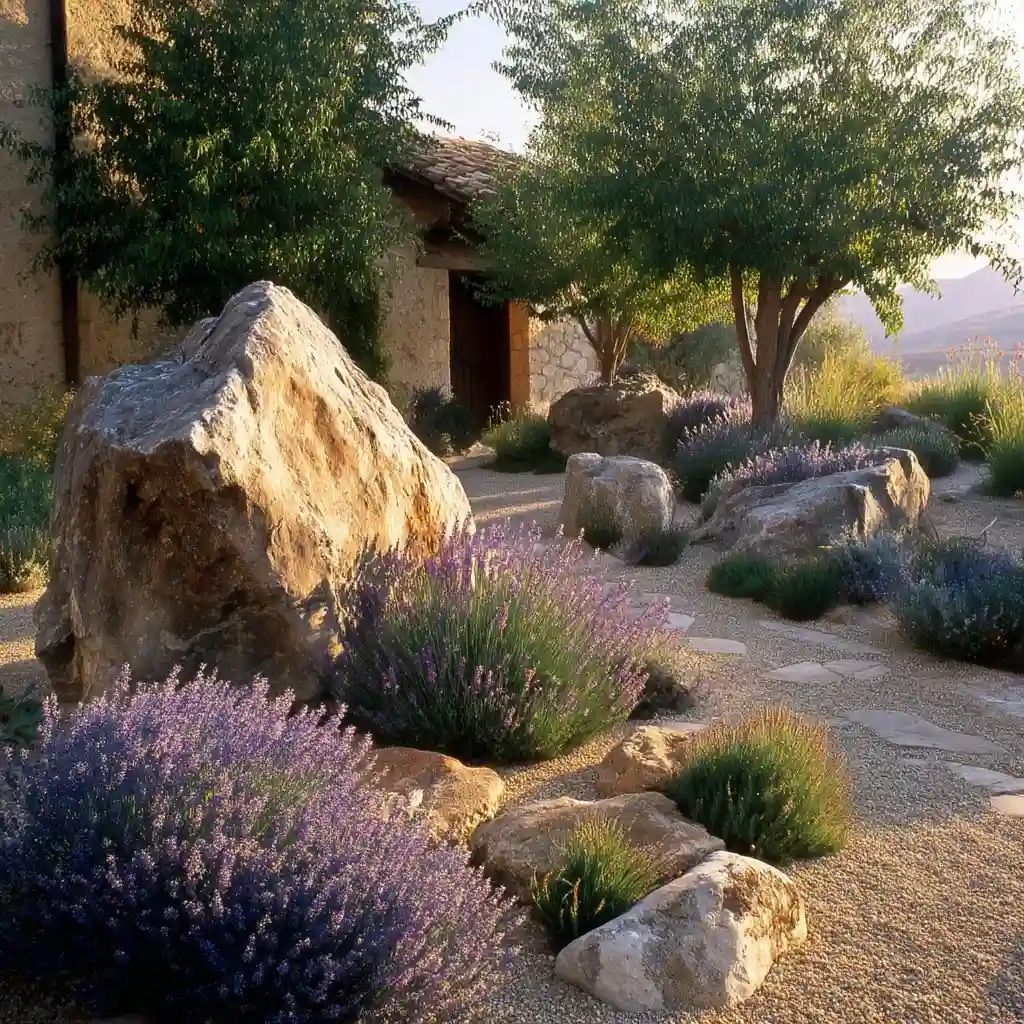
Integrating lavender into a rock garden is one of the most resilient and drought-tolerant lavender garden ideas you can try. Lavender thrives in rocky, well-draining soil and full sun—making it a perfect match for this naturally low-maintenance landscape style.
The contrast between the soft purple blooms and rugged stones creates an eye-catching texture that looks beautiful throughout the seasons. Plus, a rock garden requires minimal watering, making it ideal for hot, dry climates or xeriscaping efforts.
Ideas for styling:
- Use large boulders to frame lavender clusters and smaller gravel for paths or mulch.
- Combine with other sun-loving, drought-resistant plants like sedum, salvia, or ornamental grasses.
- Opt for irregular shapes to create a more organic, natural look.
This approach not only celebrates the rugged beauty of lavender but also reduces your water bill and garden upkeep year-round.
6. Vertical Lavender Wall Garden
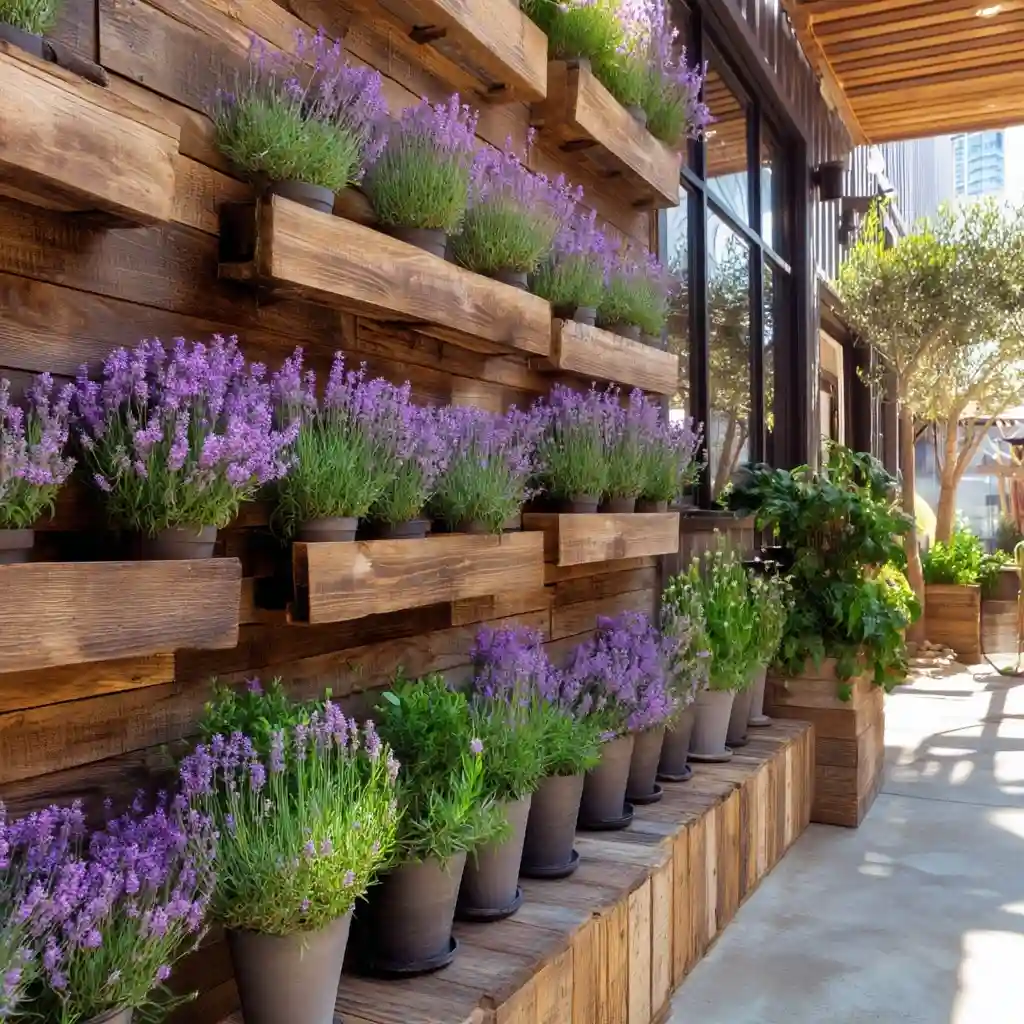
When space is limited, vertical gardening becomes one of the smartest lavender garden ideas for maximizing beauty without sacrificing square footage. While lavender is traditionally grown in-ground, certain compact varieties adapt well to vertical planters, especially in sunny, sheltered spots.
A vertical lavender wall not only adds visual height and structure to your garden but also fills the air with calming fragrance right at nose level. It’s a great option for balconies, patios, or narrow side yards where ground planting isn’t possible.
Vertical garden tips:
- Use wall-mounted planters, tiered shelving, or a sturdy trellis system.
- Choose dwarf or compact lavender types like ‘Munstead’ or ‘Little Lottie.’
- Ensure proper drainage and use a lightweight, sandy soil mix.
With the right setup, your lavender wall will double as living art—bringing color, scent, and pollinators to even the smallest spaces.
7. Lavender and Rose Companion Planting
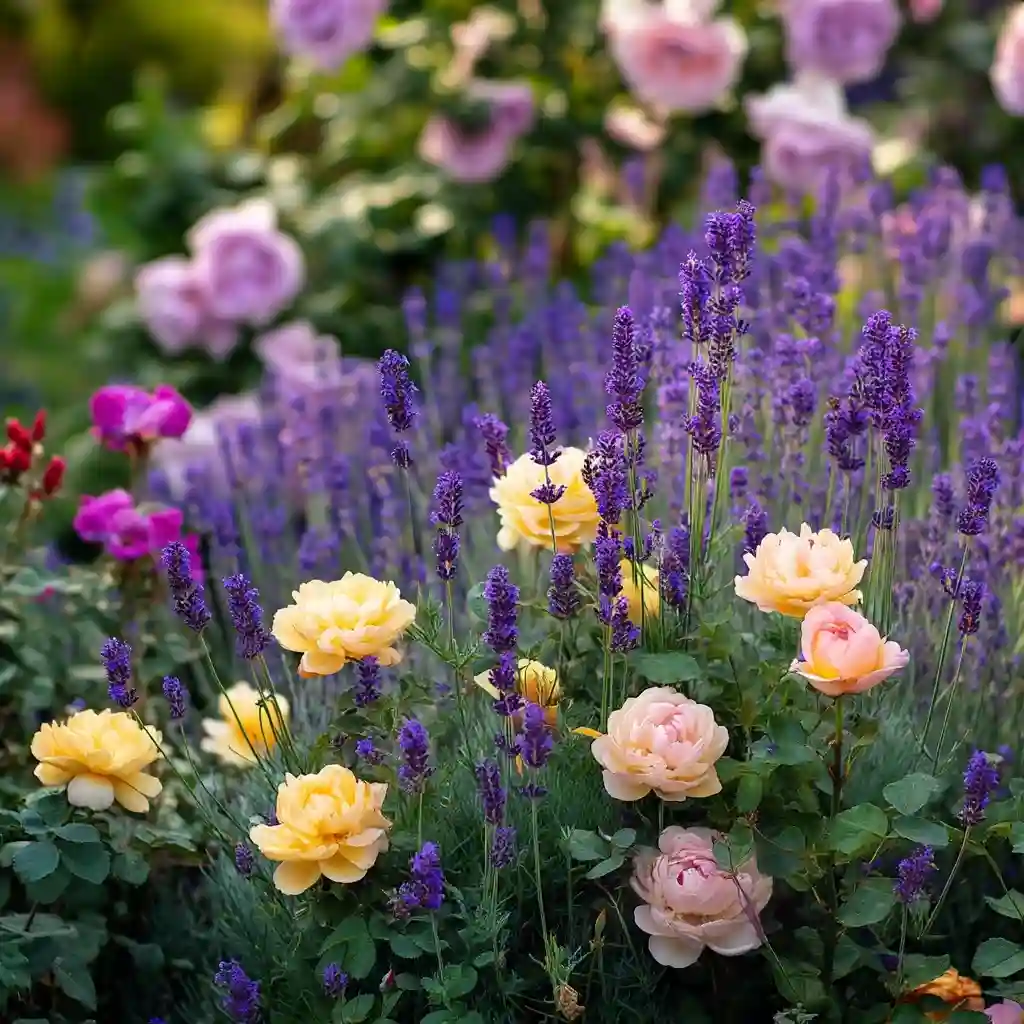
Pairing lavender with roses is one of the most timeless and elegant lavender garden ideas, blending beauty, fragrance, and function in one harmonious planting. These two classic garden favorites not only look stunning together, but they also support each other in practical ways.
Lavender’s strong scent helps deter aphids and other pests that commonly target roses, while its silvery foliage adds contrast to the deep green leaves and vibrant blooms of rose bushes. Plus, both plants enjoy full sun and well-drained soil, making them natural companions.
Planting tips:
- Place lavender at the front of rose beds for a soft, fragrant border.
- Use English or French lavender varieties that won’t overshadow low-growing roses.
- Leave enough space for airflow to prevent mildew and overcrowding.
This pairing elevates your flower beds with a layered look that appeals to the senses—and to pollinators.
8. Lavender Patio Planters
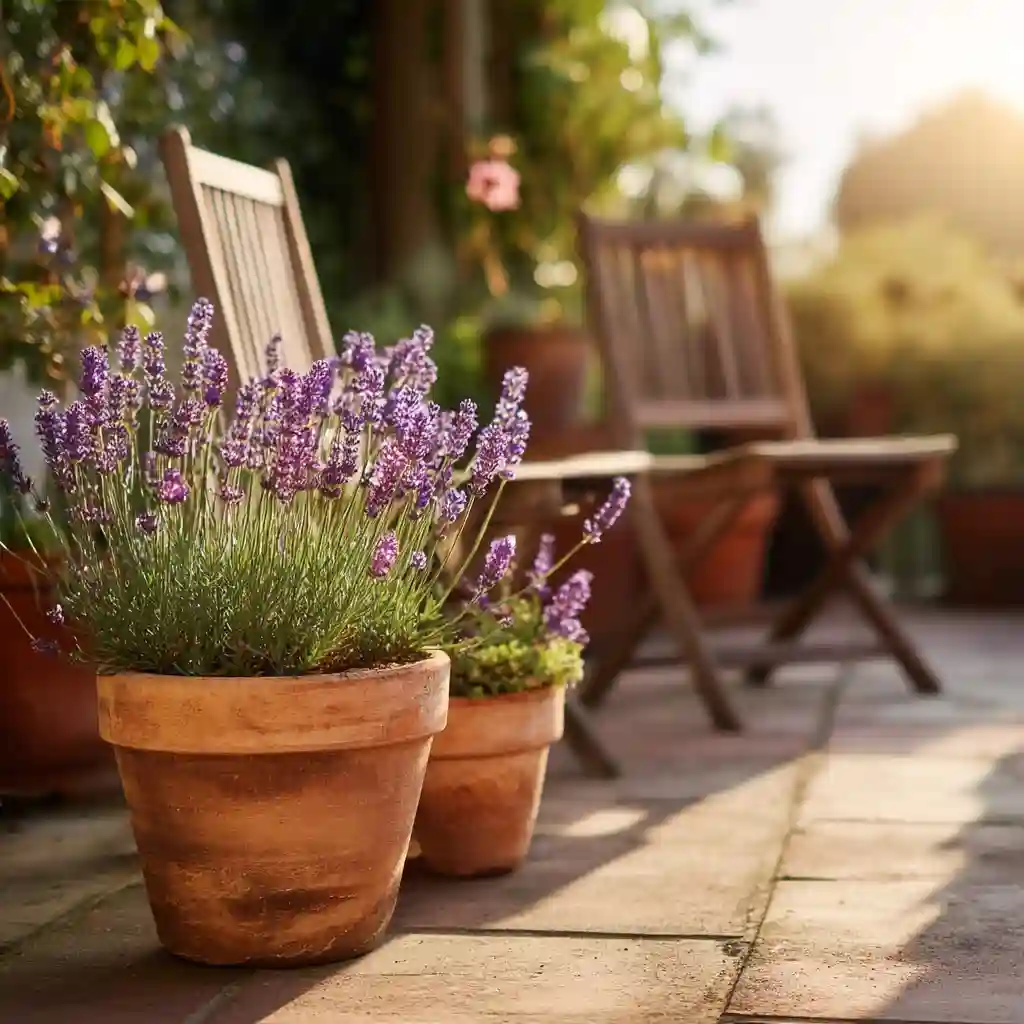
For those looking to bring fragrance and charm right to the doorstep, patio planters are one of the most versatile lavender garden ideas. Whether you’re decorating a front porch, balcony, or backyard patio, potted lavender adds color, scent, and a touch of elegance to any outdoor space.
Container gardening also gives you full control over soil quality and drainage—two essentials for healthy lavender growth. It’s an ideal solution for renters or anyone without in-ground garden space.
Container gardening tips:
- Use clay or terracotta pots for breathability and a classic look.
- Choose a fast-draining soil mix with added sand or grit.
- Water only when the top inch of soil is dry—lavender prefers slightly dry conditions.
Place planters near seating areas or entryways so you can enjoy the scent every time you step outside.
9. Wildflower and Lavender Meadow
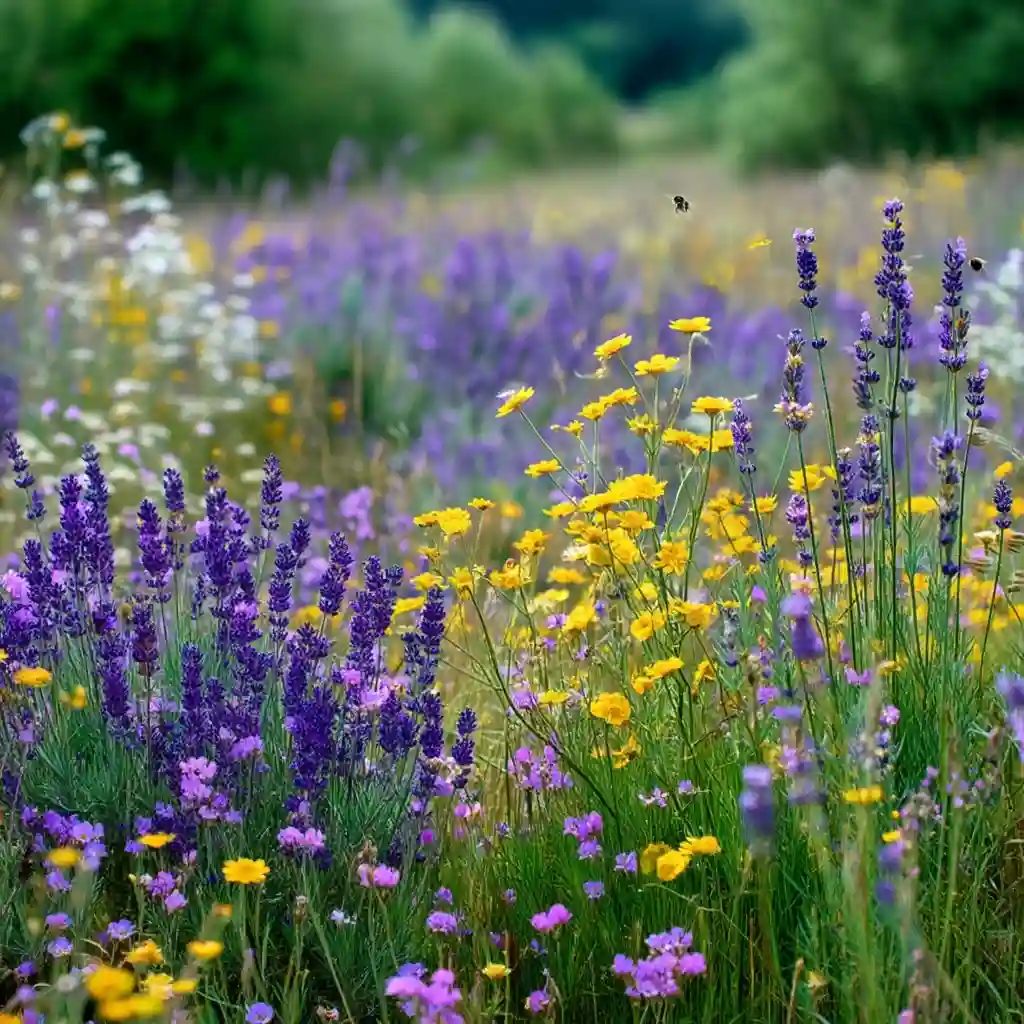
Transforming part of your yard into a wildflower and lavender meadow is one of the most naturalistic and pollinator-friendly lavender garden ideas. This style celebrates a free-flowing, untamed aesthetic—perfect for large open spaces or areas you want to rewild with low maintenance.
Lavender adds structure, fragrance, and long-lasting color to a wildflower mix. Its tall, spiky blooms complement the softer forms of daisies, poppies, and native grasses, creating a dynamic and ever-changing display throughout the growing season.
How to create this look:
- Choose a mix of native wildflowers suited to your region and climate.
- Scatter lavender plants throughout the meadow in clusters for visual impact.
- Mow only once or twice a year to encourage reseeding and protect habitats.
This meadow-style garden supports bees, butterflies, and beneficial insects, while offering a relaxed, countryside charm right in your own backyard.
10. Lavender Garden with Stone Pathway
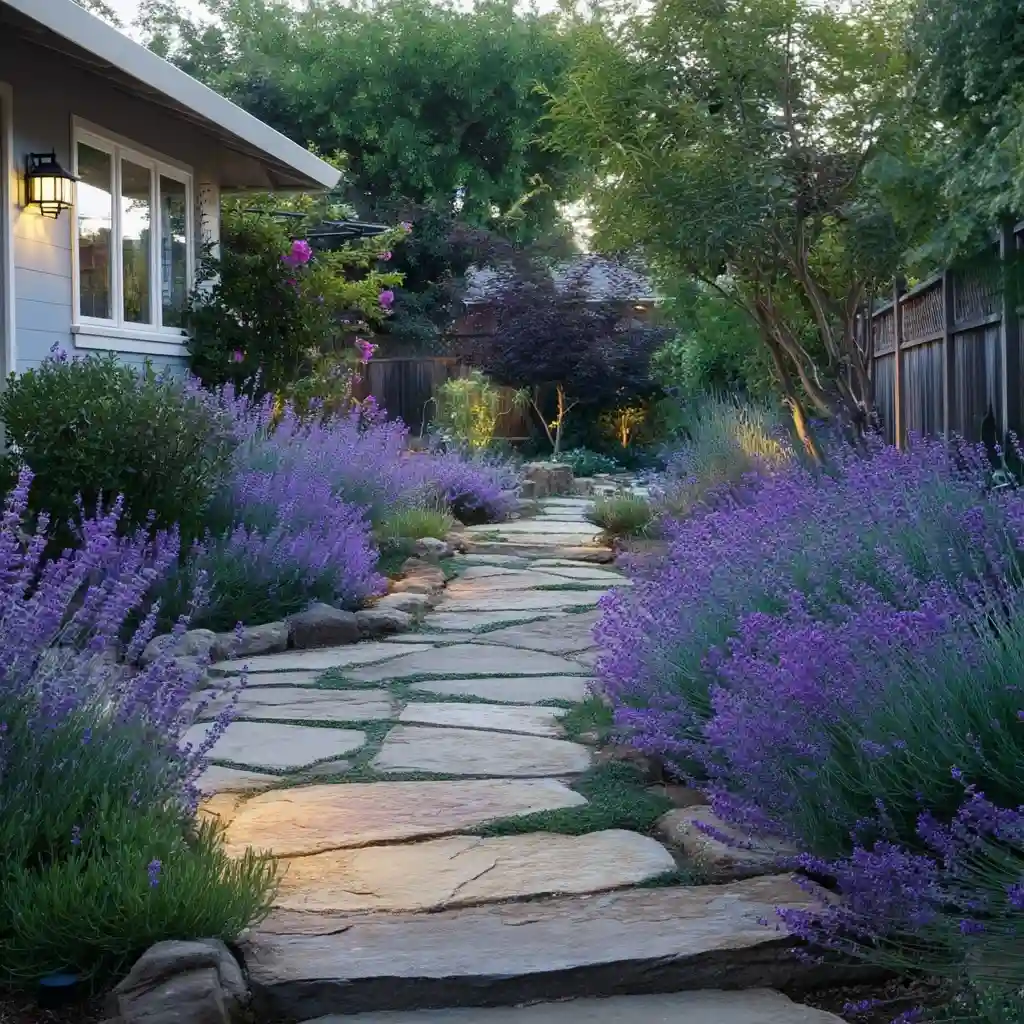
Combining a stone pathway with blooming lavender is one of the most practical and picturesque lavender garden ideas. The hardscape provides structure and walkability, while the lavender softens the edges with texture, color, and fragrance.
This pairing works beautifully in both formal and informal garden designs. The scent of lavender brushing against your legs as you walk the path adds a sensory richness that elevates the experience of simply strolling through your yard.
Design ideas:
- Use irregular flagstones or natural slate for a rustic feel, or geometric pavers for a cleaner look.
- Plant lavender in between stepping stones or along both sides of the path for symmetry.
- Choose low-growing varieties like ‘Hidcote’ to prevent overgrowth onto the walkway.
A lavender-lined stone path not only improves accessibility in your garden but turns every step into a moment of calm and beauty.
11. Lavender and Water Feature Garden
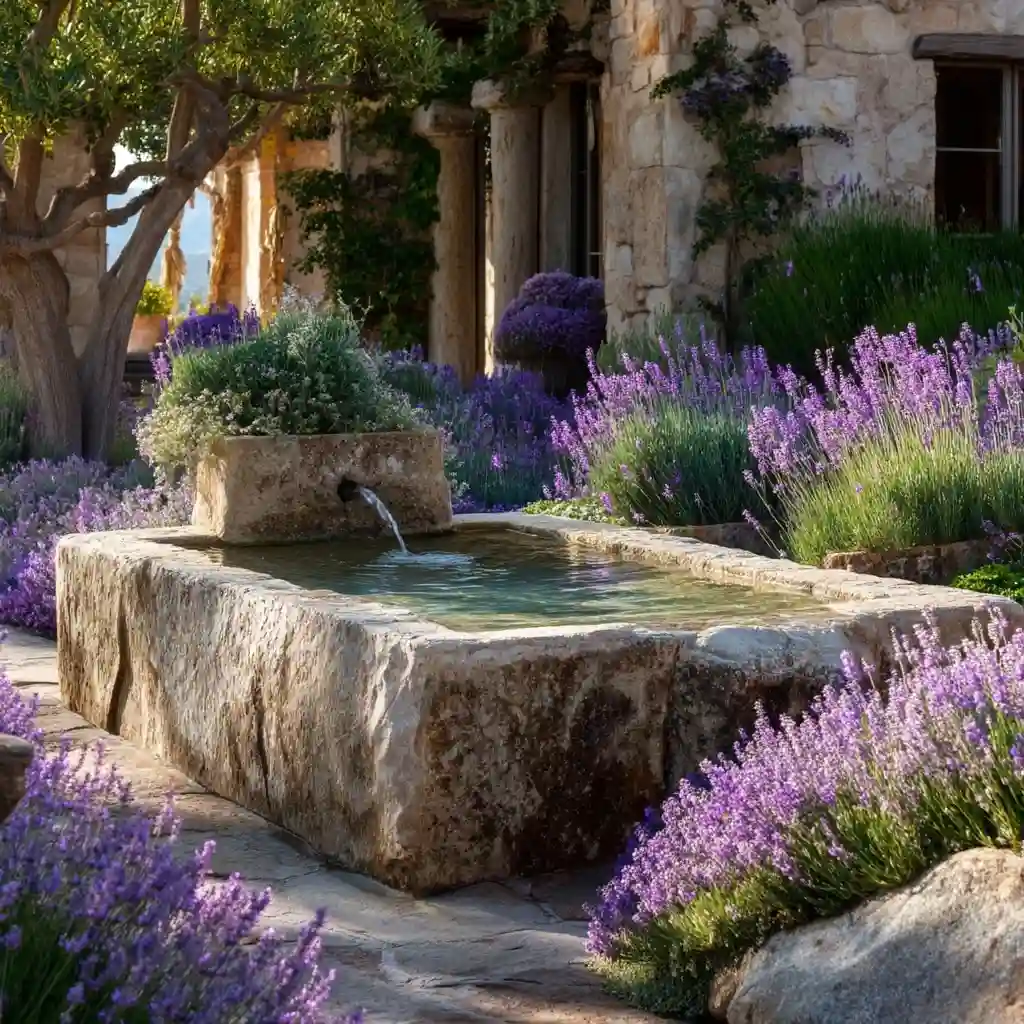
Pairing lavender with a water feature creates one of the most tranquil and visually captivating lavender garden ideas. The gentle sound of trickling water combined with the soothing scent of lavender fosters a peaceful atmosphere ideal for relaxation or meditation.
The contrast between water’s cool, reflective surface and lavender’s soft, sun-loving blooms also adds depth and dimension to your garden. Whether you choose a fountain, birdbath, or small pond, lavender makes a perfect companion plant.
Design tips:
- Position lavender just outside the splash zone to keep its roots dry.
- Frame a water feature with lavender on one or more sides to guide the eye.
- Add complementary plants like rosemary, catmint, or creeping thyme for a cohesive Mediterranean look.
This pairing not only enhances your garden’s ambiance but also invites birds, bees, and butterflies to enjoy the space with you.
12. Mediterranean-Style Lavender Courtyard
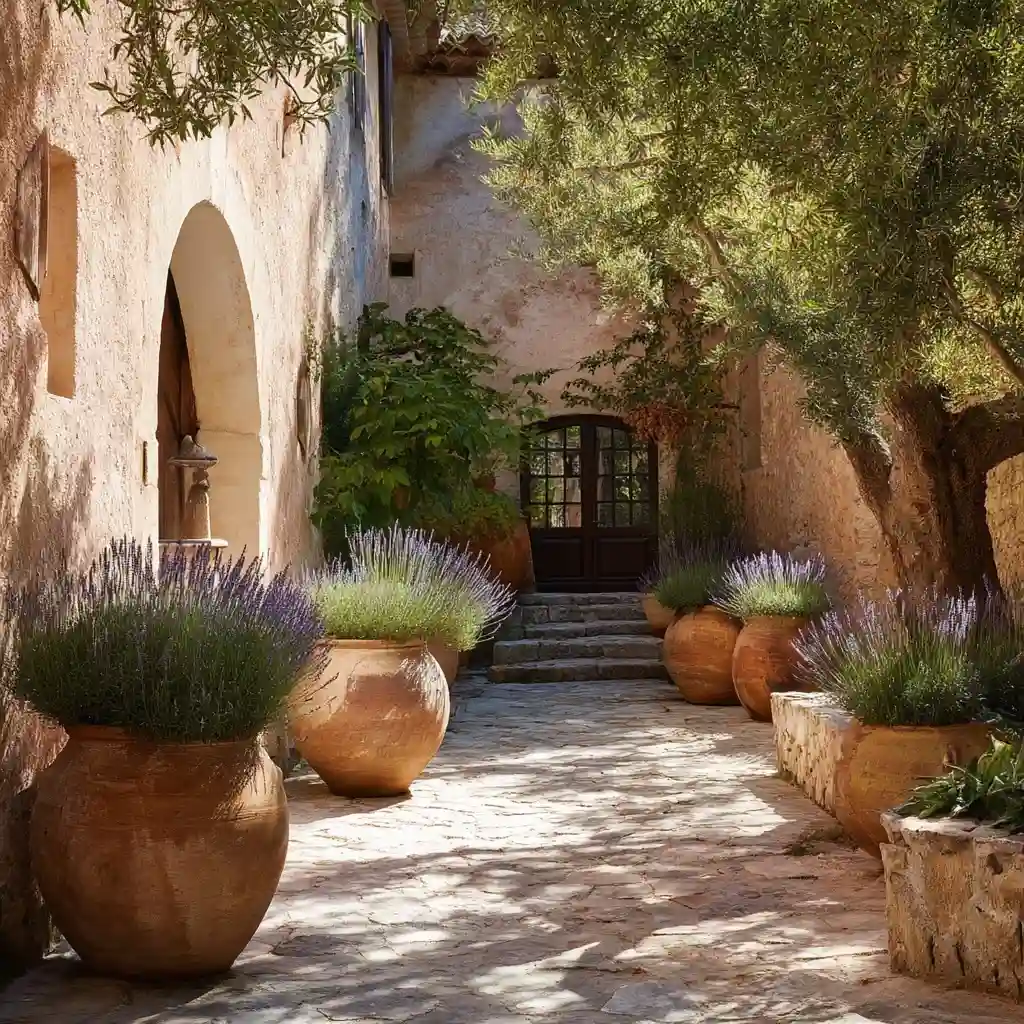
Drawing inspiration from sun-soaked European gardens, a Mediterranean-style courtyard is one of the most timeless and elegant lavender garden ideas. Lavender thrives in hot, dry conditions with plenty of sunlight—exactly the environment this design replicates.
In this setting, lavender becomes both a focal point and a unifying element, complementing terracotta pots, stone paving, and rustic stucco walls. Its silvery foliage and soft purple blooms add contrast to warm-toned materials and arid textures.
Ideas to incorporate:
- Use potted lavender in matching clay planters around a central seating area or fountain.
- Surround the courtyard with gravel beds planted with lavender, rosemary, and olive trees.
- Accent with wrought-iron furniture and ceramic tile for an authentic Mediterranean touch.
This style not only suits lavender’s growing needs but also creates a sun-drenched escape that feels like a mini vacation—right in your backyard.
13. Lavender and Butterfly Garden
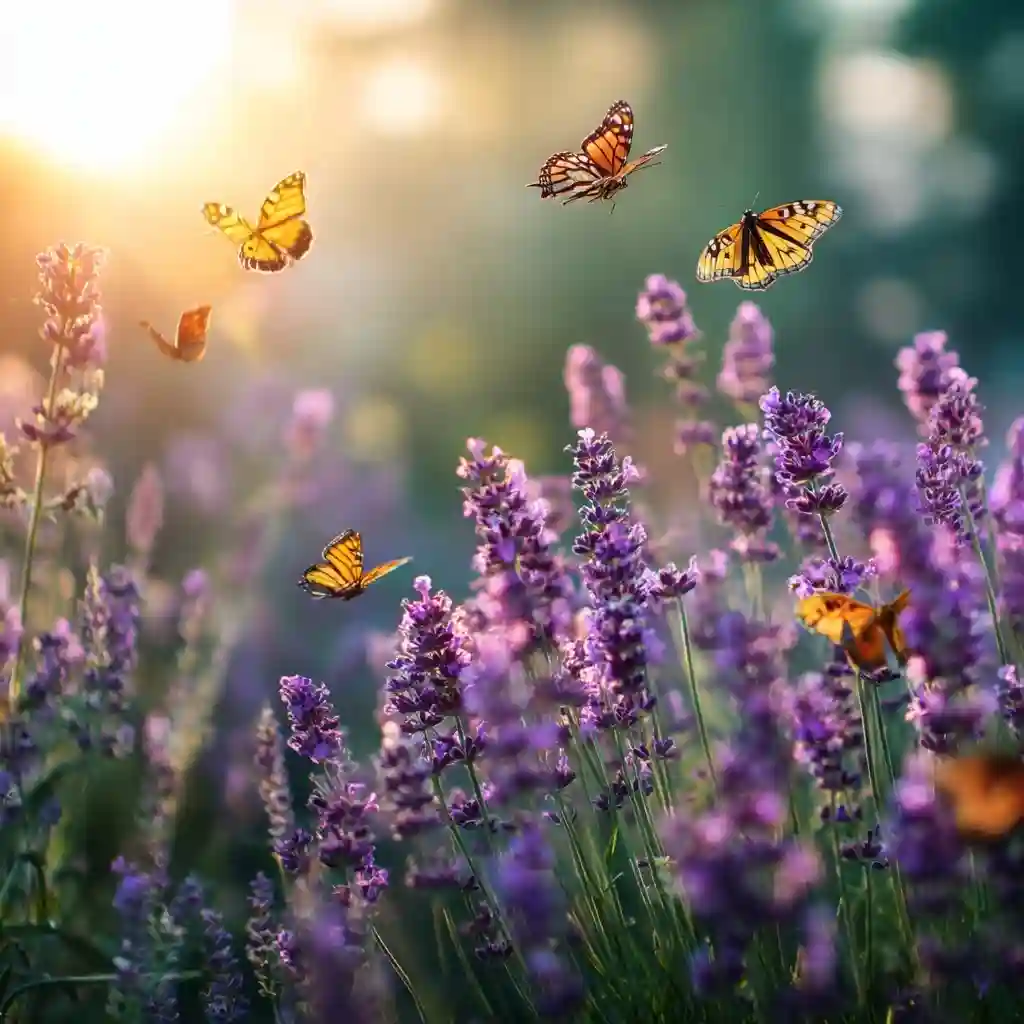
Designing a butterfly-friendly space is one of the most rewarding lavender garden ideas, and lavender happens to be a top choice for attracting these graceful pollinators. Its nectar-rich flowers are a favorite of butterflies, bees, and hummingbirds alike—making it an essential plant for any wildlife garden.
By pairing lavender with other butterfly-attracting blooms, you can create a vibrant, fluttering haven that buzzes with life throughout the growing season.
Best companion plants:
- Coneflowers, milkweed, black-eyed Susans, and bee balm for continuous blooms.
- Yarrow and verbena for added color and nectar variety.
- Avoid pesticides and herbicides to keep the garden safe for pollinators.
Arrange plants in clusters and layers so butterflies can easily navigate from flower to flower. Add flat stones for sunbathing and shallow dishes of water for hydration to complete this beautiful, beneficial habitat.
14. Fragrant Lavender Seating Area
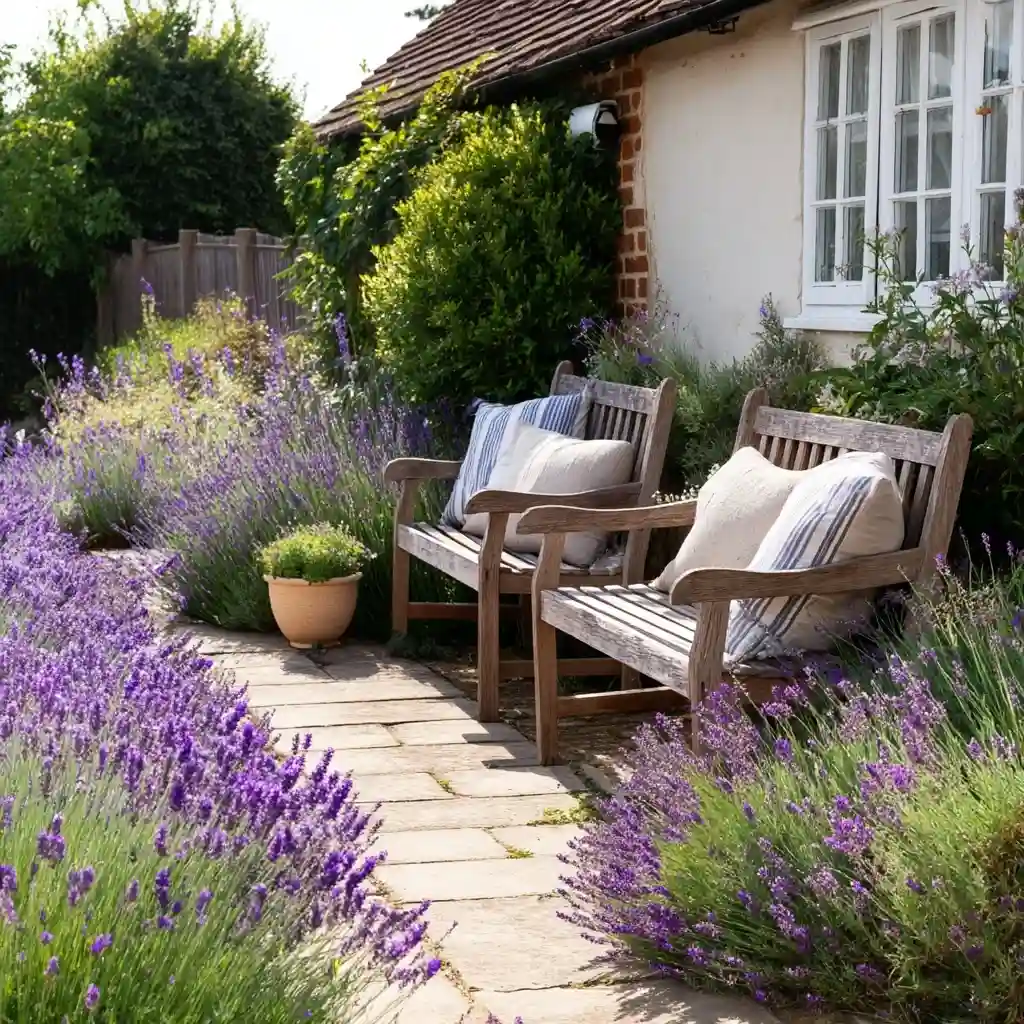
Creating a dedicated seating space surrounded by lavender is one of the most calming and sensory-rich lavender garden ideas. Whether it’s a bench under the sun or a shaded nook with comfortable chairs, placing lavender nearby enhances every moment spent outdoors with its relaxing aroma and gentle movement in the breeze.
This idea works beautifully in both large and small gardens. The key is to plant lavender close enough that its scent is noticeable—but with enough space to allow air circulation and avoid crowding.
Ways to design your space:
- Border a patio or gravel pad with lavender on two or three sides.
- Use low-growing varieties like ‘Pink Perfume’ or ‘Little Lady’ to define the space without obstructing the view.
- Add cushions, lanterns, or a pergola for extra comfort and charm.
The result is a peaceful escape that invites you to slow down, breathe deep, and simply enjoy your garden.
15. Lavender-Themed Zen Garden
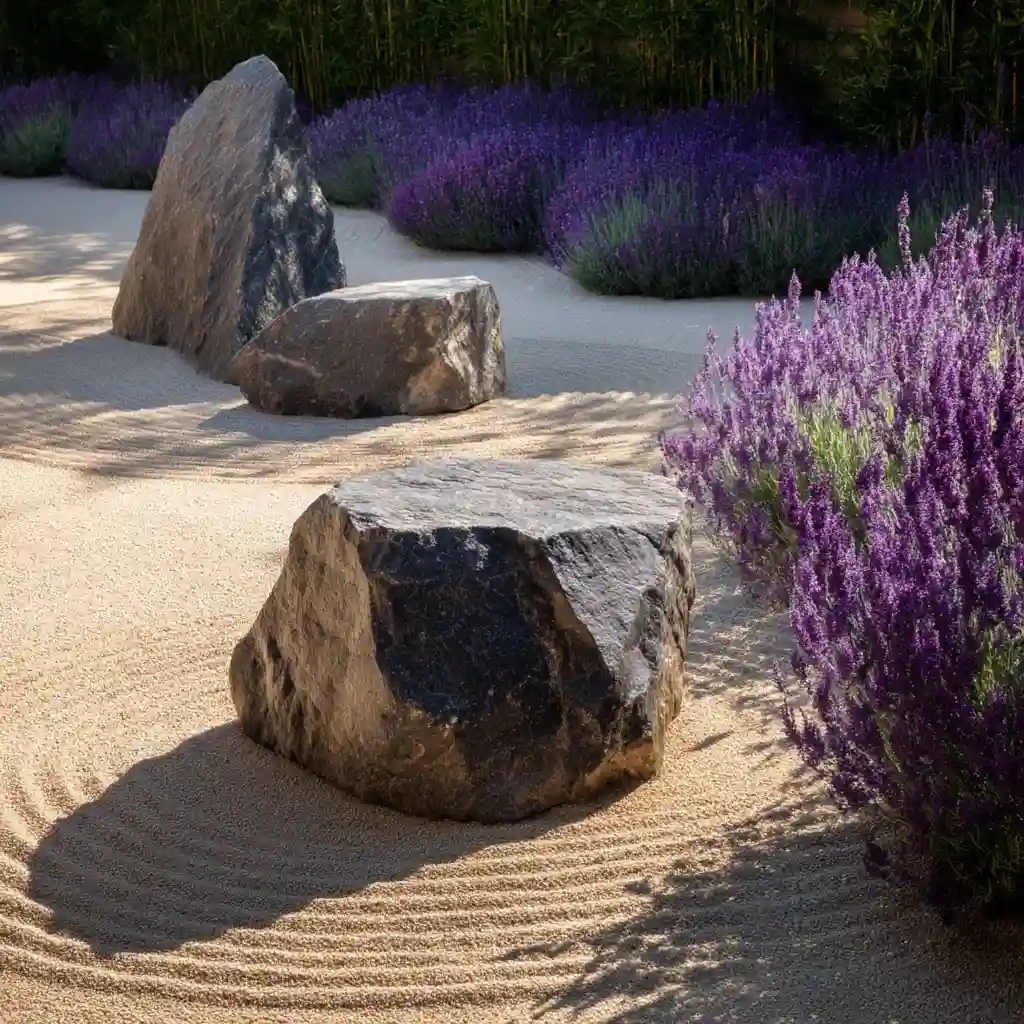
Blending Eastern-inspired minimalism with the soothing essence of lavender, a Zen garden is one of the most unique and mindful lavender garden ideas. Traditionally, Zen gardens focus on balance, simplicity, and the calming effect of natural elements—lavender fits seamlessly into this philosophy.
The soft movement of lavender in the breeze, combined with its calming scent, enhances the meditative feel of a space designed for quiet reflection.
Elements to include:
- Raked gravel or sand to symbolize water and encourage mindfulness.
- Strategically placed lavender plants around boulders, lanterns, or a stone bench.
- Add bamboo, moss, or dwarf pines for visual variety and texture.
Choose compact, neatly shaped lavender varieties to maintain the clean lines typical of Zen design. This garden style is perfect for small spaces or tucked-away corners where you want to escape and recharge.
Conclusion
Incorporating these lavender garden ideas into your outdoor space doesn’t just elevate your landscaping—it transforms your garden into a fragrant retreat that soothes the senses and supports nature. Whether you prefer structured hedges, wildflower meadows, or cozy patio planters, there’s a lavender design that fits your space and style.
Lavender’s resilience, low-maintenance nature, and year-round charm make it a favorite for gardeners of all experience levels. With a little planning, you can enjoy its scent, color, and pollinator benefits season after season.
FAQ
What type of lavender is best for garden beds?
English lavender, such as ‘Hidcote’ or ‘Munstead’, is ideal for most garden beds due to its compact shape, cold hardiness, and classic fragrance.
How much sun does lavender need?
Lavender thrives in full sun. Aim for at least 6 to 8 hours of direct sunlight per day for healthy growth and abundant blooms.
Can lavender grow in containers?
Yes, lavender grows very well in containers, especially when planted in well-draining soil and placed in a sunny spot. Choose dwarf varieties for best results.
How often should I water my lavender?
Once established, lavender is drought-tolerant. Water deeply but infrequently—only when the soil is completely dry, especially in pots.
When should I prune lavender?
The best time to prune is after flowering, typically in late summer or early fall. Trim back about one-third of the plant to keep it bushy and prevent woody growth.
🌿 Love gardening inspiration? Follow me on Pinterest for bold plant ideas, tips, and seasonal color!
More Posts
